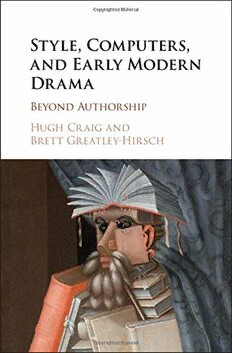
Style, Computers, and Early Modern Drama: Beyond Authorship PDF
Preview Style, Computers, and Early Modern Drama: Beyond Authorship
Hugh Craig and Brett Greatley-Hirsch extend the computational analysis GC rr introduced in Shakespeare, Computers, and the Mystery of Authorship ea ai (edited by Hugh Craig and Arthur F. Kinney; Cambridge, 2009) beyond tg , l Style, Computers ea problems of authorship attribution to address broader issues of literary yn history. Using new methods to answer long-standing questions and -Hd and Early Modern i challenge traditional assumptions about the underlying patterns and r s c contrasts in the plays of Shakespeare and his contemporaries, the authors h Dr ama shed light on, for example, different linguistic usages between plays written in verse and prose, company styles and different character types. As a shift E S Cr from a canonical survey to a corpus-based literary history founded on a a t Beyond Authorship a r y ig an statistical analysis of language, this book represents a fundamentally new ly le d G approach to the study of English Renaissance literature and proposes a new M , C Hugh Craig and rea model and rationale for future computational scholarship in early modern o o t ley literary studies. d m Brett Greatley-Hirsch - H e p ir r u s ch Hugh Craig is Professor of English at the University of Newcastle, n t . 97 Australia. D er 8 1 r s 1 0 7 a a 1 Brett Greatley-Hirsch is University Academic Fellow in Textual Studies 9 m n 1 01 and Digital Editing at the University of Leeds. a d 3 . J k t . C ‘This is an outstanding book of major importance... As well as conveying M new knowledge of exceptional interest, it is written in a style that makes it Y comprehensible by a wide, non-specialist readership. I anticipate that it will K generate intense interest, not least because it debunks a series of current myths about authorship and the style of drama in Shakespeare’s time, and introduces new methods of literary criticism.’ Gabriel Egan, Director, Centre for Textual Studies, De Montfort University Printed in the United Kingdom Cover illustration: The Librarian, Giuseppe Arcimboldo (c1566). Oil on canvas. Skoklosters Castle collection (SKO 11616). STYLE, COMPUTERS, AND EARLY MODERN DRAMA BeyondAuthorship Hugh Craig and Brett Greatley-Hirsch extend the computational analysis introduced in Shakespeare, Computers, and the Mystery of Authorship(editedbyHughCraigandArthurF.Kinney;Cambridge University Press, 2009) beyond problems of authorship attribution to address broader issues of literary history. Using new methods to answerlong-standingquestionsandchallengetraditionalassumptions about the underlying patterns and contrasts in the plays of Shake- speare and his contemporaries, Style, Computers, and Early Modern Dramashedslighton,forexample,differentlinguisticusagesbetween playswritteninverseandprose,companystyles,anddifferentcharac- tertypes.Asashiftfromacanonicalsurveytoacorpus-basedliterary historyfoundedonastatisticalanalysisoflanguage,thisbookrepre- sentsafundamentallynewapproachtothestudyofEnglishRenais- sance literature and proposes a new model and rationale for future computationalscholarshipinearlymodernliterarystudies. hugh craig, University of Newcastle, Australia, has published on authorship attribution problems, mainly in Shakespeare, and on widerstylisticquestions.Hehasongoingcollaborationsinbioinfor- maticsandspeechpathology,resultinginarticlesinsomeleadingsci- encejournals.HeisontheAuthorshipAttributionBoardforTheNew OxfordShakespeareandisaFellowoftheAustralianAcademyofthe Humanities. brett greatley-hirschisUniversityAcademicFellowinTextual Studies and Digital Editing at the University of Leeds. He is Coor- dinating Editor of Digital Renaissance Editions and co-editor of Shakespeare,thejournaloftheBritishShakespeareAssociation.Before moving to the United Kingdom, he served as Vice President of the AustralianandNewZealandShakespeareAssociation. STYLE, COMPUTERS, AND EARLY MODERN DRAMA Beyond Authorship HUGH CRAIG UniversityofNewcastle,Australia BRETT GREATLEY-HIRSCH UniversityofLeeds UniversityPrintingHouse,Cambridgecb28bs,UnitedKingdom OneLibertyPlaza,20thFloor,NewYork,ny10006,usa 477WilliamstownRoad,PortMelbourne,vic3207,Australia 4843/24,2ndFloor,AnsariRoad,Daryaganj,Delhi-110002,India 79AnsonRoad,#06-04/06,Singapore079906 CambridgeUniversityPressispartoftheUniversityofCambridge. ItfurtherstheUniversity’smissionbydisseminatingknowledgeinthepursuitof education,learningandresearchatthehighestinternationallevelsofexcellence. www.cambridge.org Informationonthistitle:www.cambridge.org/9781107191013 doi:10.1017/9781108120456 C HughCraigandBrettGreatley-Hirsch2017 ⃝ Thispublicationisincopyright.Subjecttostatutoryexception andtotheprovisionsofrelevantcollectivelicensingagreements, noreproductionofanypartmaytakeplacewithoutthewritten permissionofCambridgeUniversityPress. Firstpublished2017 PrintedintheUnitedKingdombyClays,StIvesplc AcataloguerecordforthispublicationisavailablefromtheBritishLibrary isbn978-1-107-19101-3Hardback CambridgeUniversityPresshasnoresponsibilityforthepersistenceoraccuracy ofurlsforexternalorthird-partyinternetwebsitesreferredtointhispublication, anddoesnotguaranteethatanycontentonsuchwebsitesis,orwillremain, accurateorappropriate. ForJohnBurrows,whomade commonwordsuncommon Contents ListofFigures pageviii ListofTables xiv Acknowledgements xvi NoteonTexts xviii Introduction 1 1Methods 29 2ProseandVerse:Sometimes‘transparent’,SometimesMeeting with‘ajolt’ 53 3SistersundertheSkin:CharacterandStyle 79 4 StageProperties:Bed,Blood,andBeyond 110 5 ‘Noveltycarriesitaway’:CulturalDrift 136 6Authorship,CompanyStyle,and horrorvacui 164 7 RestorationPlaysand‘theGiantRace,beforetheFlood’ 202 Coda 224 AppendixA:Play-TextsintheFullCorpus 227 AppendixB:Characterswith!2,000WordsofDialoguefrom243 PlaysPerformedontheCommercialStage,1580–1642 240 AppendixC:PlaysFirstAppearingontheCommercialStage 1590–1609,withTotalsforProp-TypesandLinesSpoken 247 AppendixD:Distributionof691Prop-Typesacross160PlaysFirst AppearingontheCommercialStage,1590–1609 255 AppendixE:AListof221FunctionWords 261 WorksCited 262 Index 278 vii Figures 1.1 PCAscatterplotof2,000-wordnon-overlappingsegmentsof playslistedinTable1.1,usingthe500mostfrequent words. page33 1.2 PCAscatterplotof2,000-wordnon-overlappingsegmentsof playslistedinTable1.1,labelledbygenre,usingthe500most frequentwords. 36 1.3 PCAbiplotof2,000-wordnon-overlappingsegmentsof playslistedinTable1.1,labelledbygenre,usingthe500most frequentwords. 37 1.4 PCAbiplotof2,000-wordnon-overlappingsegmentsof playslistedinTable1.1,labelledbygenre,usingthe500most frequentwordsandhighlightingpersonalpronouns. 38 1.5 Binarydecisiontreediagram. 40 1.6 Diagramofasinglebinarydecisiontreepopulatedfor RandomForestsclassificationof2,000-word non-overlappingsegmentsinatrainingdatasetof109 segmentsdrawnfromplayslistedinTable1.1,usingthe500 mostfrequentwords. 43 1.7 DeltadistancesbetweenGalateaandfourauthorialsub-sets. 46 1.8 DeltadistancesforTheJewofMaltaandfourauthorial sub-sets. 47 2.1 PCAscatterplotofproseandversepartsfor7Shakespearean charactersusingthe100mostfrequentfunctionwords. 60 2.2 PCAbiplotofproseandversesamplesfrom7Shakespearean characters,usingthe100mostfrequentfunctionwords, highlightingthe48mostweightedword-variables. 61 2.3 Columnchartofword-variablesexceedingthe0.01 probabilitythresholdinthegroupsplaysdetailed inTables2.2–2.4. 69 viii Figures ix 2.4 Columnchartofword-variablesexceedingthe0.01 probabilitythresholdinthegroupsplaysdetailedin Tables 2.2–2.5. 72 2.5 Columnchartofword-variablesexceedingthe0.01 probabilitythresholdinthegroupsofplaysdetailedin Tables2.2and2.5. 73 3.1 Distancesbetweencharactersinplaysandtheirsequels,using percentagecountsofthe100mostcommonfunctionwords combinedbySquaredEuclideanDistance. 82 3.2 Histogramofdistancesbetween666charactersbasedon percentagecountsofthe100mostcommonfunctionwords (221,445pairingsintotal). 83 3.3 Thez-scoresforthe20mostcommonfunctionwordsfor OrgilusandIthoclesinJohnFord’sTheBrokenHeart,using averagesandstandarddeviationsfromthefullsetof666 characterswith!2,000wordsofdialogue. 85 3.4 Distancesforthetenclosestmatchesfortencharacterswith veryclosepairingswithanothercharacter. 87 3.5 The10closestpairingsforthe11characterswithdialogues !8,000words,orderedbythedistancetotheirclosest match. 89 3.6 Thez-scoresforthe20mostcommonfunctionwordsfor Fluellen(HenrytheFifth),usingaveragesandstandard deviationsfromthefullsetof666characterswith!2,000 wordsofdialogue. 91 3.7 Thez-scoresforthetenclosestmatchesfortencharacters withverydistantclosestmatches,orderedbydistancetothe closestmatch. 93 3.8 Totalwordsspoken,numberofandcombinedtotalwords spokenbycharacterswith!2,000wordsofdialogue in11playsperformedin1599byprofessionalcompanies. 96 3.9 Thez-scoresforthe20mostcommonfunctionwordsfor BrutusandCassiusinShakespeare’sJuliusCaesar,using averagesandstandarddeviationsfromthesetof666 characterswith!2,000wordsofdialogue. 97 3.10 Hierarchicalclusteranalysisof35characterparts,using Ward’sLinkageandSquaredEuclideanDistance,basedon countsofthe100mostcommonfunctionwords. 99
